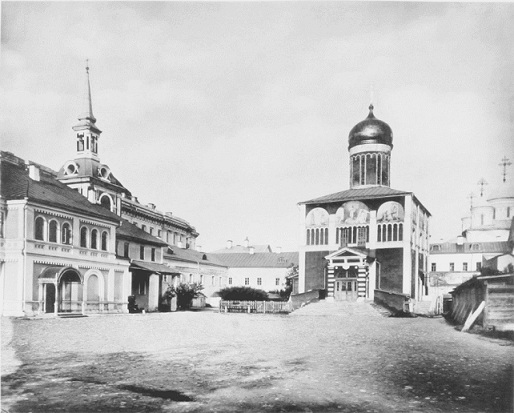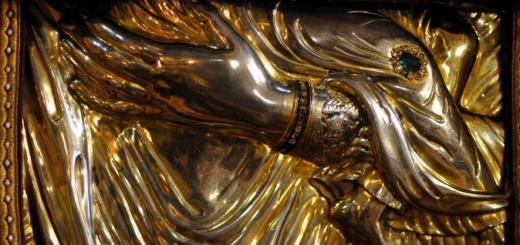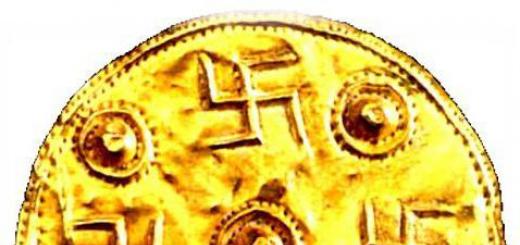Moscow period 1325-1461
Alexy Metropolitan of Kyiv
Saint Alexy Myropolitan
Saint Alexis, Metropolitan of Kyiv and All Russia, the miracle worker (in the world - Eleutherius Fedorovich Byakont) was born between 1292-1305. in Moscow in a boyar family.
Father - boyar Fedor Byakont, a native of Chernigov.
Mother - Maria Byakont.
Childhood and upbringing
Born in Moscow in the family of the boyar Fyodor Byakont and his wife Maria, natives of Chernigov. The family of the future Primate occupied a prominent place among the Moscow boyars of the late XIII-XIV. The boyars were his younger brothers - Feofan (Fofan), the ancestor of the Fofanovs (under the Grand Dukes Ioann Ioannovich Krasny and Dimitri Ioannovich Donskoy), and Alexander Pleshchey, the ancestor of the Pleshcheevs (under the Grand Duke Dimitri Ioannovich).
Early chronicle sources (the Rogozhsky chronicler and the Simeonovskaya chronicle, reflecting the Moscow collection of 1409) call St. Alexis in baptism Simeon, and the life written in 1459 by Pachomius Logofet, and later chronicles - Eleutherius (the colloquial form Olfer (Alfer) corresponds to the initial letter monastic name) in some lists of the XVII century. The Nikon chronicle gives both names together. It is possible that the sources reflect the existence of the so-called direct name (corresponding to the saint whose memory falls on his birthday) and baptismal name (a situation well known in the example of double Christian princely names) in Saint Alexy. The close proximity of the names Eleutherius and Simeon is observed in the calendar twice: Simeon the Holy Fool, commemorated July 21, and the martyr Eleutherius, commemorated August 4; Simeon, relative of the Lord, commemorated September 18, and Eleutherius, martyred with Dionysius the Areopagite, commemorated October 3; the first 2 memories are also present in the shortest versions of the month-word, known in the 14th century.
Indications of the date of birth even in the oldest story of the Code of 1409 are very contradictory. In sufficiently detailed chronological calculations, on the basis of which the year of birth is considered to be 1293: “in Chernitsy, you will be tonsured for 20 years, and in Chernetsy, you will live for 40 years, and you will be appointed metropolitan for 60 years, and stay in the metropolitan for 24 years . And the life of all the days of his life is 85 years ”- only the duration of his stay at the head of the metropolis is reliable. At the same time, an indication of 40 years of monastic life could have appeared as a result of a misunderstanding of the message that St. Alexis “stay in the clergy even up to 40 years”, which is rather not about the duration of the monastic feat, but about the approximate age at appointment of St. Alexy as sovereign governor.
When determining the time of birth, preference should be given to mentioning contemporary historical figures and events to St. Alexis that do not agree with the date of 1293: “In the reign of the great Tfersky Mikhailov Yaroslavich, under Metropolitan Maxim, until the murder of Akinfov” (that is, before the campaign against Pereyaslavl in the winter of 1304- 1305 of the Tver boyar Akinf the Great). An important piece of evidence from the story that St. Alexis is “the oldest prince of the great Semyon (born in 1317) 17 years old”, referring the birth of the saint to 1300, cannot be unconditionally accepted, since a typo (error of internal dictation) in the record is possible here numbers influenced by the sound of the name ("Seeds" - "seventy" instead of "thirteen"). If we consider the year of birth of St. Alexis 1300, then Andrei Alexandrovich Gorodetsky, and not Mikhail Yaroslavich, should have been mentioned as the Grand Duke (although the latter returned from the Horde with a label for a great reign in the fall of 1305, that is, after the murder of Akinfov, the later the biographer of St. Alexis could calculate the beginning of a new reign from the date of the death of Prince Andrei - July 27, 1304). The godfather of Saint Alexis was Prince John Danilovich (future Kalita).
tonsured
According to his life, having learned to read and write at an early age, St. Alexis already in his adolescence began to dream of a monastic life, after one day, falling asleep while catching birds with snares, he heard a voice calling him a monastic name and foreshadowing that he would become a "catcher of men."
At the age of 19, he was tonsured at the Epiphany Monastery in Zagorodye (modern Kitay-Gorod), by the elder brother of St. Sergius, Abbot Stefan, confessor of the Grand Dukes.

Icon "St. Alexis, Metropolitan of Moscow". XVII century.
Beginning of church activities
Until the age of 40, Alexy led a monastic life. About most of this period, it is only known that St. Alexis "every good will of the monastic life is corrected and every scripture of the Old and New Laws is gone." Undoubtedly, at this time he continued to maintain ties with the grand ducal court.
On the initiative of the Grand Duke (not earlier than 1344), the saint was appointed vicar of the aged Metropolitan Theognost and moved to the metropolitan courtyard. Metropolitan Theognost, even during his lifetime, blessed Alexy "in his place as a metropolitan."
From 6 December 1352 to June 1354 title Bishop of Vladimir
worn by Saint Alexis.
Thus, it was restored for a short time, abolished in 1300 in connection with the resettlement of the Kiev metropolitans to Vladimir; after the elevation of St. Alexis to the rank of metropolitan, the department was again liquidated.

State-diplomatic activity
An embassy was sent to Constantinople from Grand Duke Simeon Ioannovich and Metropolitan Theognost to obtain the consent of the Patriarch to approve the candidacy of St. Alexis. Already at this time, the role of St. Alexis in the state affairs of the Grand Duchy of Moscow was very great: according to the spiritual diploma of Grand Duke Simeon, the future metropolitan remained an adviser to his younger brothers, Princes Ivan and Andrei.
Appointment by the Kiev Metropolitan
Upon the return of the embassy to Moscow, which secured the consent of Patriarch Philotheus, Saint Alexis set off for Constantinople. On the way, he received in the Horde a travel letter (label) from Taydula, the wife of Khan Uzbek: with the letter, the retinue, convoy and property of the saint were protected from all possible encroachments. Saint Alexy spent about a year in Constantinople. The desk charter of Patriarch Philotheus to the new metropolitan is dated June 30, 1354, according to which Saint Alexis, not being a Greek, was elevated to the rank of metropolitan as an exception, for his virtuous life and spiritual merits. To assist in the administration of the diocese, he was given as exarch Deacon George Perdika, who probably did not fulfill these duties for long (perhaps until January 1359, when St. Alexis went to Lithuania), since already in 1361 he was again in Constantinople.
By the same charter, at the request of St. Alexis, Vladimir was approved as the seat of the Russian metropolitans with the preservation of Kyiv as their first throne.

Hagiographic icon of St. Alexis (Dionysius, 1480s)
The nomination and approval of a successor by the Patriarch of Constantinople during the latter’s lifetime was caused by the desire to preserve the unity of the metropolia and limit the interference in the affairs of the Church by non-Orthodox secular rulers, since by that time the territory of the Kiev Metropolis was politically subject, in addition to Russian princes, to partially Polish Catholic kings and pagan grand dukes. Lithuanian. From con. 13th century attempts were periodically repeated (for various reasons, short, but reflecting a general trend) to create separate metropolises in the southwestern Russian lands, initially at the initiative of the Orthodox Galician-Volyn princes, later - Polish kings and Grand Dukes of Lithuania. These attempts were especially intensified under Grand Duke Olgerd, who subjugated most of the western and southwestern Russian lands and claimed dominance over all Russian principalities. These plans were hindered by the existence of the Church, which was not under his control, the head of which was from con. 13th century was in the Grand Duchy of Vladimir. Olgerd needed a special metropolitan for his own possessions, or an All-Russian one, but subordinate to the Grand Duke of Lithuania.
Even during the life of Metropolitan Theognost, at the end of 1352, the monk Theodoret appeared in Constantinople with a false report of the death of the head of the Russian Church, who sought his appointment to the allegedly vacant metropolitan see. It is not known for certain whether he was a protege of Olgerd or his brother, the Orthodox Volyn prince Lubart. The impostor was not appointed in the capital of Byzantium and, in violation of the canonical rules, was elevated to the rank of metropolitan by the Bulgarian Patriarch Theodosius in Tarnovo. Despite the non-canonicity of the appointment, Theodoret was received in Kyiv, which was not yet part of the Grand Duchy of Lithuania, and the Archbishop of Novgorod Moses, dissatisfied with the policies of Metropolitan Theognost and Grand Duke Simeon, was inclined to recognize his authority. In the Patriarchal message of 1354 addressed to the Novgorod Bishop, it was ordered to obey the legally installed metropolitan - Saint Alexy, and not Theodoret. Already during the stay of St. Alexis in Constantinople, Bishop Roman of Tver, who was patronized by Olgerd, arrived there to be installed as a metropolitan for the Lithuanian possessions. According to the Rogozhsky chronicler, he had already received an appointment from the Bulgarian Patriarch, like Theodoret, but was not received in Kyiv.
Probably, Kallistos (1350-1353, 1355-1364), who replaced Patriarch Philotheus (1353-1354, 1364-1376), appointed Roman to the restored Lithuanian Metropolis (c. 1317 - c. 1330) with a see in Novogrudok, which included Polotsk and Turov dioceses and eparchies of Little Russia (the lands of the former Galicia-Volyn principality). The rest of the metropolis, together with Kiev, was retained by Saint Alexy, along with the title of "Metropolitan of All Russia." However, Roman immediately violated the limits set for him by sending his ambassadors to Tver to Bishop Theodore (at the same time St. Alexis also sent ambassadors to him).
Activities as head of the Kiev Metropolis
Returning to Russia, Saint Alexy appointed bishops: Ignatius in Rostov, Basil in Ryazan, Theophylact in Smolensk, and John in Saray. But already a year after his return - in the autumn of 1355 - he went again to Constantinople (where his rival Roman had arrived even earlier) to decide on the legitimacy of the division of the metropolis. According to the chronicler, "there was a great dispute between them and great gifts from them." The result was a confirmation on the part of the Patriarch of the previous conditions, and St. Alexy returned to Russia in the winter of 1355/1356. On the way back, he got into a storm on the Black Sea and vowed to found a monastery in case of salvation. By this vow was created Andronikov Monastery in Honor of the Image of the Savior Not Made by Hands in Moscow.
Mission to the Horde
In August 1357, at the invitation of Khansha Taidula, Saint Alexy went to the Horde and healed her of an eye disease. The label given in November of this year by Taidula to St. Alexis, traditional in content, has been preserved: according to it, the Russian Church, praying for the khans, is freed from all tributes, extortions and violence from the secular authorities. According to a late tradition (which has not received unequivocal confirmation during archaeological excavations), in addition to a label, in gratitude for the healing of Taidula, Saint Alexy also received a land plot in the Moscow Kremlin, occupied by the Horde farmstead (or Khan's stables).
Foundation of the Chudov Monastery
In the Kremlin in 1365, Saint Alexy founded a stone church in the name of the Miracle of the Archangel Michael in Khonekh and founded the Miracle Monastery under him.

Chudov Monastery 
Temple in the name of the Miracle of the Archangel Michael in Khonekh
The Miracle Monastery was founded by Saint Alexy, Metropolitan of Moscow, in commemoration of gratitude for the help and miraculous healing of the wife of the Tatar Khan Dzhanibek Taidula - at that time she was almost blind and was already losing hope of recovery when Metropolitan Alexy was invited. The prayers of the saint had an effect - the khansha received her sight and, in gratitude, presented the metropolitan with the territory of the Embassy Court of the Golden Horde in the Kremlin near the Spassky Gates. This was the place of the future monastery, consecrated in the name of the Miracle of the Archangel Michael in Khonekh - a unique dedication that was not found anywhere else in Moscow. The monk of the Chudov Monastery was the famous Grishka Otrepyev, also known as False Dmitry I.
The Chudovskaya Convent was also known as a place for the baptism of the royal children: since the time of Ivan the Terrible, heirs to the Moscow throne, and then some emperors, were baptized here (in particular, the future Emperor Alexander II was baptized here in 1818).
The monastery also served as a place of imprisonment: Metropolitan Isidore was planted here in 1441, signing the Union of Florence (later he fled to Europe) - the history of the autocephalous Russian Orthodox Church actually begins with his deposition.
However, the most famous prisoner of the Chudovskaya monastery was Patriarch Hermogen, who was tortured by the Poles in 1612 because of his refusal to support the prince Vladislav and the blessing of the militia soldiers (canonized in 1913 during the celebration of the tercentenary of the Romanov dynasty, at the same time the side church was consecrated in his honor) .
A little later here, in 1666, another Moscow patriarch, Nikon, was deposed by the Ecumenical Patriarchs.
It was in the Miracle Monastery that Patriarch Filaret set up a "patriarchal school" - a Greek-Latin school, which became the forerunner of the Slavic-Greek-Latin Academy.
Arseniy Grek and Epiphanius Slavinetsky, a native of the famous Kiev-Mohyla Academy, who worked in Chudovo and corrected liturgical books, taught here...
According to his life, St. Alexis led a debate about faith in the Horde in the presence of the khan. During the stay of St. Alexis in the Horde, civil strife began here, caused by the illness of Khan Dzhanibek and his murder, but the metropolitan safely returned to Russia.
Relations with Lithuania
Relations between the Kiev (in Moscow) and Kiev-Lithuanian metropolitans continued to be tense. Based on the military successes of Olgerd, who subdued his power to the end. 50s 14th century The Principality of Bryansk, a number of Smolensk destinies and Kyiv, the Lithuanian Metropolitan Roman, in violation of the conditions for becoming a metropolitan, extended his power to Bryansk and the capital center of the metropolis (from the beginning of the 50s of the XIV century Smolensk and Bryansk were vassals of the Grand Duke of Vladimir) .
In January 1359, during the Smolensk-Muscovite-Lithuanian hostilities, St. Alexis went to Kyiv (probably to enlist the support of the southern Russian princes), but was captured by Olgerd, robbed and imprisoned.
However, Saint Alexy managed to escape, and in 1360 he returned to Moscow. In the same year, again violating the conditions, Metropolitan Roman arrived in Tver. In 1361, following the complaints of St. Alexis, Patriarch Kallistos discussed the issue of the borders of the Kievan and Lithuanian metropolises, confirming the conditions of 1354.
During the absence of Saint Alexis in Moscow, Grand Duke John Ioannovich died, and Saint Alexius turned out to be in fact one of the regents for the young Demetrius (born in 1350). Under these conditions, in the first half of the reign of Grand Duke Dimitri Ivanovich, the role of Saint Alexy, which had been significant even in the years of the “quiet and meek” Ivan Ivanovich, increased even more (although until the death in 1365 of the Princess Mother, the influence of her brother, the Moscow thousand). The Suzdal prince Dmitry Konstantinovich received a label for the great reign of Vladimir, and the young Moscow prince temporarily lost many territorial acquisitions. The opportunity for a new upsurge of the Moscow principality and its dynasty is largely due to Saint Alexy, who linked the fate of the metropolis with them and used his authority as the First Hierarch in their interests. It was a deeply conscious choice made long before the regency under Prince Dimitri Ioannovich.
The church policy of Olgerd did not give St. Alexis the possibility of a compromise, a position of non-intervention in the struggle between the two rival political centers - Moscow and Lithuania, even if we leave aside the Moscow roots and connections of St. Alexis, the Grand Duke of Lithuania needed not cooperation with the Orthodox Church, but its subordination his political plans. A pagan head of state, the overwhelming majority of whose population was Orthodox, married twice to Russian princesses and bound by marriage unions with Orthodox princes, Olgerd could not, of course, ignore the existence of the Church, but looked at her mainly as an auxiliary instrument of his external and domestic policy. In his negotiations with the Ecumenical Patriarch, he set the creation of a special metropolia under his control as an obligatory condition for his conversion to Orthodoxy and the baptism of pagan Lithuania. Such a metropolis was created twice during the years of his reign (in 1355 and 1375), but there was no retaliatory step - Olgerd himself was baptized, according to legend, only on his deathbed (and according to German sources, he died a pagan). Therefore, apparently, St. Alexis did not even hesitate in his choice between a stubborn fire-worshipper and the Orthodox princes of Moscow, whose ancestors at one time provided significant support to St. Metropolitan Peter in a difficult moment for him.
Periods of relatively peaceful relations between Olgerd and St. Alexis were infrequent and short-lived. The most significant of these occurred in 1363-1368, when, after the death of Metropolitan Roman (1362), Saint Alexy traveled to Lithuania and, apparently, reached an agreement with the Grand Duke there, as a result of which he installed a bishop in Bryansk. Then, the following summer, Saint Alexy baptized in Tver the daughter of Olgerd, brought from Lithuania by her grandmother, the widow of Prince Alexander Mikhailovich of Tver, Anastasia.
The opposition of the Grand Duchy of Vladimir to the eastward expansion of Lithuania and the seizure of Russian lands by the Lithuanian grand dukes was hampered by the lack of political unity among the Russian princes. On the Great Table of Vladimir along with the Moscow Danilovichs in the late 50s - 60s. 14th century claimed the Suzdal prince Dmitry Konstantinovich (in 1359-1362 he even really occupied him), and in 1371-1374. and in 1375 - Prince Mikhail Alexandrovich of Tverskoy. The primary task of St. Alexis as the leader of Moscow politics was to establish a balance of power in the region under the leadership of Moscow and, if possible, restore political and ecclesiastical influence in Smolensk and Bryansk, achieved by Grand Duke Simeon Ioannovich and lost with the loss of his young nephew of the Vladimir table. Relying on the authority of the Metropolitan of All Russia at that time allowed Grand Duke Dimitri Ivanovich to ignore the labels for a great reign, issued to his rivals in the Horde torn by strife, often replaced by khans and pretenders to the Sarai throne, and defend their interests by force of arms. At the same time, with the same goal, St. Alexis sought to prevent the predominance of pro-Lithuanian forces in those northern Russian principalities where they existed (the family of Prince Alexander Mikhailovich in Tver, Olgerd's son-in-law Boris Konstantinovich Gorodetsky in the Nizhny Novgorod principality), acting as the supreme arbiter in intra-dynastic strife. While faithful to the interests of Moscow, his policy in these matters was very balanced and did not bear the character of rude and undisguised support of "us" against "them." Even the Tver chronicle (the Rogozhsky chronicler), which has preserved the largest number of news about the activities of St. Alexis and is not too friendly towards him, only once, in connection with the forcible detention in Moscow in 1368 of Prince Mikhail Alexandrovich, contains a direct accusation against the saint (it should be borne in mind that for that time such a forcible detention was a very mild form of pressure on the Tver prince in order to sign a peace treaty on Moscow terms). In all controversial situations known from sources, St. Alexis acts as a champion of the time-honored tradition. In the conflict of 1357 between the Grand Duke of Tver Vasily Mikhailovich and his nephews, the children of Alexander Mikhailovich executed in the Horde, Saint Alexy took the side of the eldest in the family (and allied with Moscow) prince against Vsevolod Alexandrovich, who laid claim to the Tver throne.
In 1363, after the death of Prince Andrei Konstantinovich of Nizhny Novgorod, the Metropolitan supported Moscow's recent rival Prince Dimitry of Suzdal in his confrontation with his younger brother Boris, who had seized Nizhny Novgorod bypassing the rights of the elder. By order of the metropolitan, his envoys - hegumen Gerasim and archimandrite Pavel, who arrived in the city to summon the prince to the metropolitan court, "shut the church." In a dispute over the inheritance of the specific Tver (Gorodok) prince Semyon Konstantinovich between the brother of the deceased, the Klin prince Yeremey, and the great prince. Mikhail Alexandrovich (to whom the inheritance was bequeathed) in 1365, the metropolitan supported his closest relative; the dispute caused a war between Moscow and Tver.
The long-term practical leadership of St. Alexis in the foreign policy of the Grand Duchy of Moscow under the princes Ioann Ioannovich and Dimitri Ioannovich gave the Muscovite-Lithuanian rivalry a tangible character of religious confrontation between Christians and pagans, and the Primate skillfully used the current situation in the interests of the Orthodox Church and the state core of the future Russia, influencing the Russians princes - vassals and allies of Olgerd. When in con. 60s 14th century Smolensk Prince Svyatoslav and a number of other princes violated the kiss of the cross given by the Grand Duke Dimitry Ivanovich about the alliance against Olgerd, and went over to the side of Lithuania, St. Alexis excommunicated them from the Church for speaking out in alliance with the pagans against Christians, and the traditional ally of Lithuania, Prince Michael, was also excommunicated Alexandrovich of Tver, as well as Bishop Vasily of Tver who supported him. These actions of St. Alexis received the understanding and support of Patriarch Philotheus, who, in a letter of 1370, offered the excommunicated princes to repent and join Demetrius. However, later Olgerd of Lithuania seized the initiative and in a letter to the Patriarch (reflected in the Patriarchal Letter of 1371) accused the metropolitan of “blessing the Muscovites for the shedding of blood” and releasing from the oath the Lithuanian subjects who went over to the side of the Muscovites. Even more dangerous on the part of the Lithuanian prince was the hypocritical accusation of St. Alexis that he did not deal with the affairs of the western part of the metropolis (although Olgerd himself was primarily to blame for this), on the basis of which a demand was put forward to create a new separate metropolis for Lithuania and its allies. (“to Kyiv, to Smolensk, to Tver, to Little Russia, to Novosil, to Nizhny Novgorod”).
In a letter sent in August 1371, Patriarch Philotheus demanded that St. Alexis remove the excommunication from the prince of Tver and come to Constantinople for a trial on the issue of the Western Russian flock, left without pastoral teaching and supervision. Later, the summons to court was canceled, but the Patriarch persistently advised the saint to seek reconciliation with Olgerd in order to provide unimpeded care to the Western Russian flock. Saint Alexis, in turn, declared that he was forced to defend himself, since the Grand Duke of Lithuania wanted to "acquire power for himself in Great Russia." Later, Olgerd put forward the demand for the permanent stay of the metropolitan in Kyiv (that is, in the Lithuanian part of the metropolis). In this regard, the visits of the Patriarchal ambassadors to Lithuania and to St. Alexis became more frequent: in 1371, John Dokian came to Moscow, and in 1374, the Bulgarian Cyprian (later Metropolitan of Moscow). As a result, largely due to the position of Olgerd, the unity of the metropolis at that time could not be maintained. As early as 1371, Patriarch Philotheus, under the threat of conversion to Catholicism of the Orthodox population of the regions subject to Poland, restored the Galician Metropolis, and in 1375, yielding to the pressure of Olgerd, appointed Cyprian to the metropolis of Little Russia and Kyiv, appointing him as the heir of St. table of all Russia. The explanation for these actions was set forth by the Patriarch in a letter delivered to Moscow at the beginning of 1377 by the ambassadors John Dokian and George Perdika, but here they were not accepted, and Cyprian, as the successor of St. Alexis, was not recognized. At that time, only Bryansk continued to remain behind St. Alexis on the territory of Lithuania, where he installed Bishop Gregory around 1375.
Results of state activity
As a church and statesman, St. Alexis stood at the origins of the successful struggle of the Grand Duchy of Moscow against the Horde yoke. He consistently pursued a policy aimed at creating a union of Russian principalities that could withstand the noticeably weakened in the 2nd half. 14th century Horde.
For the first time such an alliance, which included remote Novgorod, was tested in a joint campaign of Russian princes against Tver in 1375; after the conclusion of a peace treaty with Moscow and the recognition of the supremacy of Grand Duke Dimitri Ioannovich, he was joined by and. The significant role of St. Alexis in the all-Russian political life is evidenced by the emergence since his time of the practice of affixing the metropolitan seal of interstate agreements (the agreement between Moscow and Novgorod with defeated Tver). He also acted as a guarantor of inter-princely relations of the Moscow ruling house. With the blessing of St. Alexis, in 1365 an agreement was concluded between the princes of the Moscow house, Dimitri Ioannovich and Vladimir Andreevich. At the same time, it follows from this agreement that the boyars played a decisive role in determining the policy of the Moscow princes. In 1372, St. Alexis sealed with his seal the first testament of Prince Demetrius presented to him, which provided for the division of lands and power after the marriage of Prince Vladimir to the daughter of the Lithuanian Grand Duke Olgerd. Between 1372 and 1378 at the request of St. Alexis, Dimitry Ioannovich handed over the Puddle and Borovsk to Vladimir Andreevich.
The results of the church activities of St. Alexis
For almost a quarter of a century of heading the Russian Church, St. Alexis appointed 21 bishops, twice in some sees, and three times in Smolensk.
During his tenure as Metropolitan, Saint Alexy contributed in every possible way to the spread and consolidation of cenobitic monasticism in Russia.
The name of St. Alexis is associated with the creation and renewal of a number of monasteries in Moscow and in the Metropolitan region. In addition to Spaso-Andronikov (1357), Chudov (about 1365) and Simonov (between 1375 and 1377) monasteries, with his blessing in 1360-1362. the Vvedensky Vladychny Monastery in Serpukhov was founded, the ancient ones, but fallen into decay near Vladimir, and the Nizhny Novgorod Annunciation Monastery were renewed. The monastic tradition also ascribes to him the creation of the Alexievsky maiden monastery in Moscow for his sisters (c. 1358), although this opinion is not shared by all researchers.
The saint founded monasteries in Nizhny Novgorod, Voronezh, Yelets and Vladimir.
Under St. Alexis, the veneration of St. Peter continued to spread. Before the trip of St. Alexis to the Horde in 1357 in the Assumption Cathedral in Moscow, at the tomb of Metropolitan Peter, “a candle was lit about itself”; after the prayer service, it was broken up to bless those present. On the feast of the Dormition of the Theotokos in 1372, according to chronicles, a boy, mute and with a paralyzed arm, was healed at the tomb of Metropolitan Peter; Saint Alexy ordered the bells to ring and a prayer service was served.
demise
The tonsure of Mityai-Michael was performed during the life of St. Alexis by the archimandrite of his Chudov Monastery, Elisha Chechetka.
He died on February 12, 1378. Before his death, he commanded Grand Duke Dimitry Ivanovich to bury himself outside the church, behind the altar of the cathedral in the Miracle Monastery. But at the insistence of the Grand Duke the First Hierarch, they were buried inside the temple, near the altar.
Fifty years after his death, he was canonized as a saint.
The relics of the saint were found in 1431 (according to other sources, in 1439 or 1438) in the Chudov Monastery in the Kremlin, which he founded, as a result of restoration work, and laid in the Church of the Archangel Michael; in 1485 they were transferred to the Alexievsky temple of the Chudov Monastery; in 1686 - in the newly built Church of the Annunciation of the same monastery, since 1947 they have been buried in the Epiphany Elokhov Cathedral in Moscow.
Heavenly patron of the Patriarchs of Moscow: Alexy I and Alexy II.
Memory
Feasts of St. Alexis are established:
February 12 (25) - death;
May 20 (June 2) - finding of relics;
September 4 (17) - Cathedral of the Voronezh Saints,
October 5 (18) - Cathedral of Moscow Saints,
June 23/July 6 at ,
August 26 (September 8) - Cathedral of Moscow Saints.
Compositions:
- Diploma of Metropolitan Alexy on Chervleny Yar to boyars, Baskaks, clergy and laity about their criminal record to the Ryazan Bishop // AI. T. 1. No. 3. S. 3-4; PDRCP. Part 1. No. 19. Stb. 167-172;
- Teachings of Metropolitan Alexy from the Acts of the Apostles to Christ-loving Christians // PrTSO. 1847. Part 5. S. 30-39;
- Nevostruev K. The newly discovered instructive message of St. Alexis, Metropolitan of Moscow and All Russia // DC. 1861. Part 1. S. 449-467;
- Leonid [Kavelin], archim. The village of Cherkizovo // Mosk. ved. 1882. June 17. No. 166, p. 4;
- Kholmogorovs V. and G. Radonezh tithe (Moscow district) // CHOIDR. 1886. Prince. 1. P. 30. Note. 2;.
Copyright © 2015 Unconditional Love










